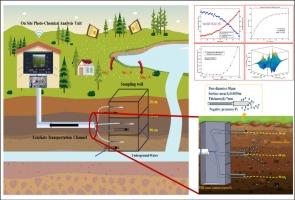农业面源污染及营养物向水体径流土壤渗滤液自动监测系统的实验验证
IF 5.9
2区 工程技术
Q1 ENGINEERING, MULTIDISCIPLINARY
引用次数: 0
摘要
尽管取得了进步,但农业面源污染及其对水质影响的精确现场测量仍然具有挑战性。现有系统在处理空间变异性和时间波动以及准确捕获水体中的营养动态方面面临局限性。本研究引入了一个创新的自动化监测框架来评估农业径流对氮(N)和磷(P)的贡献。本研究还提出了一个创新的数学建模框架和实验验证,用于监测农业非点源污染的自动土壤渗滤液收集系统(ASLCS),特别关注氮(N)和磷(P)动态,整合土壤水动力学、压力变化和传感器响应。该模型在模拟30、60和90 cm多个深度的土壤含水量方面具有优异的精度,RMSE值分别为0.0038、0.0044和0.0036 m3/m3。土壤渗滤液收集率与土壤含水量呈较强的相关性(各深度R2 >; 0.98),土壤含水量在0.28 m3/m3以上时收集效率最高。压力动态分析显示归一化压力与体积之间存在复杂的关系(R2 = 0.9911和0.9977),超声液位计在工作范围内具有较高的测量精度(R2 = 0.9902)。设计的模型监测营养物质浓度的能力显示出优异的精度,验证结果表明,NH4-N (R2 = 0.9968, 0-10 mg/L范围)、NO3-N (R2 = 0.9960, 0-20 mg/L范围)和磷(R2 = 0.9943, 0-5 mg/L范围)具有较高的准确性。这种综合方法代表了自动化监测技术的重大进步,提供了实时、高精度的农业养分淋失跟踪,同时最大限度地减少了土壤破坏。本文章由计算机程序翻译,如有差异,请以英文原文为准。

Experimental validation of an automated soil leachate monitoring system for agricultural Non-Point source pollution and nutrient run-off to water bodies
Despite advancements, precise on-site measurement of agricultural non-point source pollution and its impact on water quality remains challenging. Existing systems face limitations in addressing spatial variability and temporal fluctuations and accurately capturing nutrient dynamics in water bodies. This study introduces an innovative automated monitoring framework to assess nitrogen (N) and phosphorus (P) contributions from agricultural runoff. This research also presents an innovative mathematical modeling framework and experimental validation for an automated soil leachate collection system (ASLCS) designed to monitor agricultural non-point source pollution, particularly focusing on nitrogen (N) and phosphorus (P) dynamics integrating soil water dynamics, pressure variations, and sensor responses. The model demonstrated exceptional accuracy in simulating soil water content across multiple depths (30, 60, and 90 cm) with remarkably low RMSE values of 0.0038, 0.0044, and 0.0036 m3/m3 respectively. The soil leachate collection rates showed a strong correlation with soil water content (R2 > 0.98 across all depths), with collection efficiency peaking at soil water contents above 0.28 m3/m3. Pressure dynamics analysis revealed sophisticated relationships between normalized pressure and volume (R2 = 0.9911 and 0.9977), while ultrasonic level sensor performance demonstrated high measurement accuracy (R2 = 0.9902) across operational ranges. The capability of the designed model to monitor nutrient concentrations showed exceptional precision, with validation results indicating high accuracy for NH4-N (R2 = 0.9968, 0–10 mg/L range), NO3-N (R2 = 0.9960, 0–20 mg/L range), and phosphorus (R2 = 0.9943, 0–5 mg/L range). This integrated approach represented a significant advancement in automated monitoring technology, offering real-time, high-precision tracking of agricultural nutrient leaching while minimizing soil disruption.
求助全文
通过发布文献求助,成功后即可免费获取论文全文。
去求助
来源期刊

Ain Shams Engineering Journal
Engineering-General Engineering
CiteScore
10.80
自引率
13.30%
发文量
441
审稿时长
49 weeks
期刊介绍:
in Shams Engineering Journal is an international journal devoted to publication of peer reviewed original high-quality research papers and review papers in both traditional topics and those of emerging science and technology. Areas of both theoretical and fundamental interest as well as those concerning industrial applications, emerging instrumental techniques and those which have some practical application to an aspect of human endeavor, such as the preservation of the environment, health, waste disposal are welcome. The overall focus is on original and rigorous scientific research results which have generic significance.
Ain Shams Engineering Journal focuses upon aspects of mechanical engineering, electrical engineering, civil engineering, chemical engineering, petroleum engineering, environmental engineering, architectural and urban planning engineering. Papers in which knowledge from other disciplines is integrated with engineering are especially welcome like nanotechnology, material sciences, and computational methods as well as applied basic sciences: engineering mathematics, physics and chemistry.
 求助内容:
求助内容: 应助结果提醒方式:
应助结果提醒方式:


